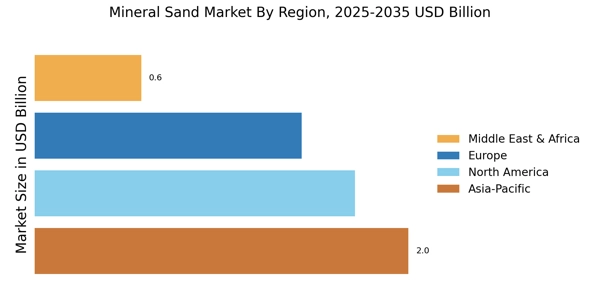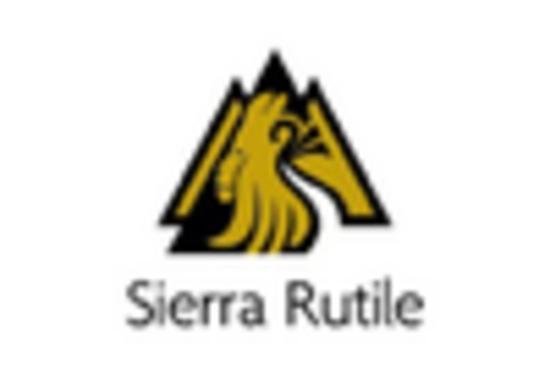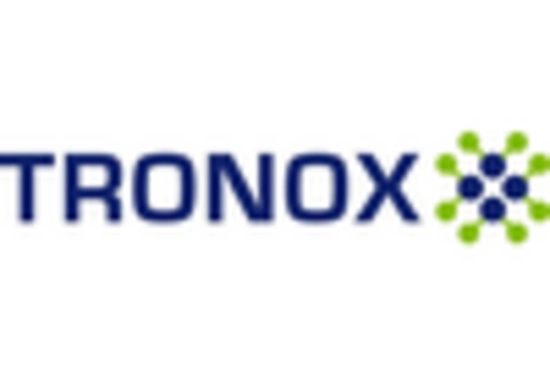Rising Demand for Titanium Dioxide
The Mineral Sand Market is experiencing a notable increase in demand for titanium dioxide, a key component derived from mineral sands. This demand is primarily driven by its extensive use in the production of paints, coatings, and plastics. In recent years, the global consumption of titanium dioxide has surged, with estimates suggesting a growth rate of approximately 4% annually. This trend is likely to continue as industries seek high-performance materials that enhance product durability and aesthetic appeal. Furthermore, the increasing focus on environmentally friendly products is pushing manufacturers to adopt titanium dioxide, which is perceived as a safer alternative to other pigments. Consequently, the Mineral Sand Market is poised to benefit from this rising demand, as producers ramp up their extraction and processing capabilities to meet the needs of various sectors.
Growing Applications in Electronics
The Mineral Sand Market is witnessing a surge in demand due to the growing applications of mineral sands in the electronics sector. Materials such as zircon and rutile are increasingly utilized in the production of electronic components, including capacitors and semiconductors. As the electronics industry expands, driven by advancements in consumer technology and the proliferation of smart devices, the need for high-quality mineral sands is expected to rise. Recent market analyses indicate that the electronics sector could account for a significant portion of mineral sand consumption, potentially reaching 20% by 2027. This trend underscores the importance of the Mineral Sand Market in supporting technological advancements and innovation across various electronic applications.
Infrastructure Development Projects
Infrastructure development projects are significantly influencing the Mineral Sand Market. Governments and private entities are investing heavily in infrastructure, including roads, bridges, and buildings, which require substantial quantities of mineral sands for construction materials. For instance, the demand for zircon and ilmenite, essential components in construction and manufacturing, is expected to rise as new projects are initiated. Recent data indicates that infrastructure spending is projected to increase by 5% annually, further driving the need for mineral sands. This trend suggests that the Mineral Sand Market will likely see a robust growth trajectory as it aligns with the ongoing global push for modernization and urbanization. The interplay between infrastructure development and mineral sand extraction is thus a critical driver of market dynamics.
Technological Innovations in Mining
Technological innovations are reshaping the Mineral Sand Market, enhancing extraction and processing efficiency. Advanced mining techniques, such as automated systems and real-time data analytics, are being adopted to optimize resource recovery and reduce operational costs. These innovations not only improve productivity but also minimize environmental impact, aligning with sustainability goals. For instance, the implementation of drone technology for surveying and monitoring has shown to increase accuracy in resource estimation. As a result, companies within the Mineral Sand Market are likely to invest in these technologies to maintain competitiveness. The ongoing evolution of mining technology suggests a promising future for the industry, as it adapts to meet both economic and environmental challenges.
Environmental Regulations and Compliance
The Mineral Sand Market is increasingly influenced by stringent environmental regulations aimed at promoting sustainable mining practices. Governments are implementing policies that require companies to adhere to environmental standards, which can impact operational costs and extraction methods. Compliance with these regulations often necessitates investment in cleaner technologies and practices, which may initially pose challenges for some operators. However, this shift towards sustainability is likely to create opportunities for companies that can innovate and adapt. The Mineral Sand Market may see a consolidation of players who prioritize environmental stewardship, potentially leading to a more responsible and sustainable market landscape. As regulations evolve, the industry must navigate these complexities while striving for profitability and environmental responsibility.


















Leave a Comment